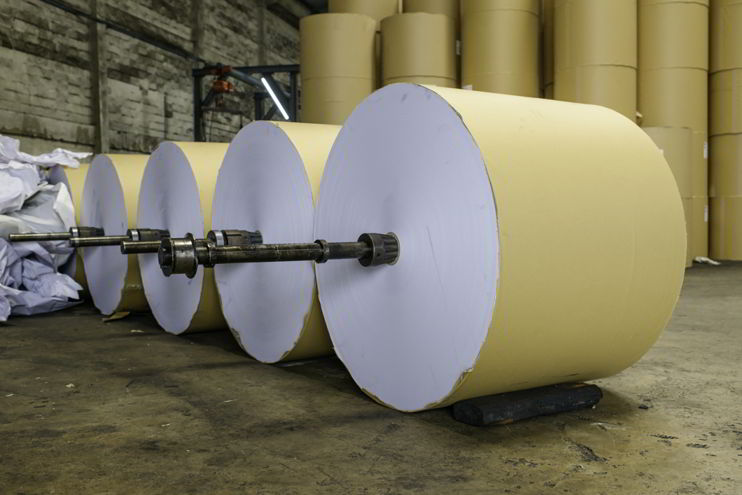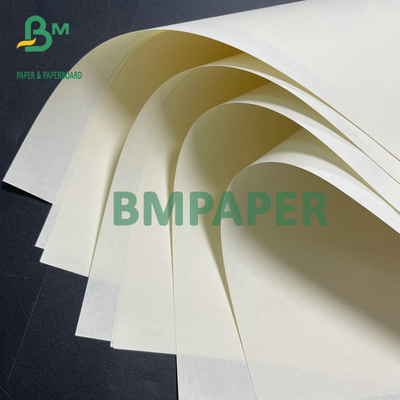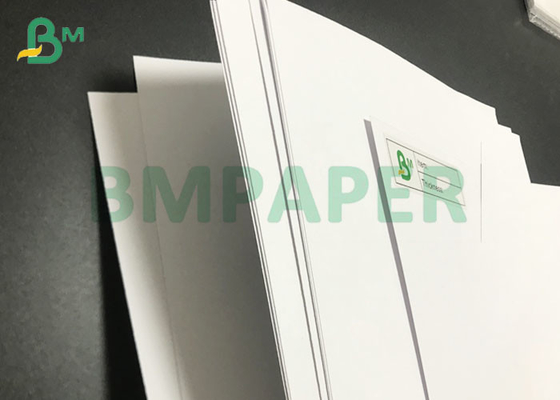Sind Offsetpapierhersteller eine Investition wert?
Hersteller von Offsetpapier
Abschnitt 1: Suche nach den besten Offsetpapierherstellern
In der Welt des Drucks ist es entscheidend, die besten Hersteller von Offsetpapier zu finden, um hochwertige Ergebnisse zu erzielen. Offsetpapier ist mit seiner glatten Oberfläche und seinen hervorragenden Farbaufnahmeeigenschaften eine bevorzugte Wahl für verschiedene Druckprojekte. Egal, ob Sie als Akzidenzdrucker oder als Privatperson auf der Suche nach Offsetpapier sind, dieser Leitfaden hilft Ihnen bei der Suche nach dem richtigen Hersteller für Ihre Bedürfnisse.
Wie man einen verlässlichen Offset identifiziert Papierhersteller
Die Suche nach zuverlässigen Offsetpapierherstellern erfordert einige Recherchen und Überlegungen. Hier sind einige Schlüsselfaktoren, die Sie im Auge behalten sollten:
- Renommee: Suchen Sie nach Herstellern mit einem guten Ruf in der Branche. Prüfen Sie ihre Erfolgsbilanz, Kundenrezensionen und Erfahrungsberichte, um sicherzustellen, dass sie durchweg Qualitätsprodukte liefern.
- Qualitätskontrolle: Entscheiden Sie sich für Hersteller, die über strenge Qualitätskontrollverfahren verfügen. Dadurch wird sichergestellt, dass Sie konsistentes und zuverlässiges Offsetpapier erhalten, das Ihre Druckanforderungen erfüllt.
- Produktpalette: Achten Sie auf Hersteller, die eine breite Palette von Offset-Papieroptionen anbieten. So können Sie die richtige Sorte, das richtige Gewicht und das richtige Format für Ihr spezielles Druckprojekt wählen.
- Anpassungsmöglichkeiten: Wenn Sie besondere Druckanforderungen haben, z. B. spezielle Oberflächen oder Sondergrößen, wählen Sie einen Hersteller, der Anpassungsoptionen für Ihre Anforderungen anbietet.
- Ökologische Nachhaltigkeit: Da die Nachfrage nach umweltfreundlichen Papierprodukten steigt, sollten Sie auf Hersteller achten, die bei ihren Produktionsprozessen auf Nachhaltigkeit setzen. Achten Sie auf Zertifizierungen wie FSC (Forest Stewardship Council), die ihr Engagement für eine verantwortungsvolle Beschaffung belegen.
Faktoren, die bei der Auswahl eines Offsetpapierherstellers zu berücksichtigen sind
Bei der Auswahl eines Offsetpapierherstellers ist es wichtig, verschiedene Faktoren zu berücksichtigen, um die beste Lösung für Ihre Anforderungen zu finden. Hier sind einige wichtige Überlegungen:
- Anforderungen des Druckprojekts: Bestimmen Sie die spezifischen Anforderungen Ihres Druckprojekts, z. B. Papiersorte, Gewicht, Helligkeit und Größe. Wählen Sie einen Hersteller, der Offsetpapier liefern kann, das diesen Spezifikationen entspricht.
- Preis und Wert: Vergleichen Sie die Preise und berücksichtigen Sie das Preis-Leistungs-Verhältnis der verschiedenen Hersteller. Erschwinglichkeit ist zwar wichtig, aber Qualität und Zuverlässigkeit sollten Vorrang haben, um die besten Ergebnisse zu erzielen.
- Produktionskapazität: Prüfen Sie die Produktionskapazitäten der Hersteller, um sicherzustellen, dass sie den Umfang und den Zeitplan Ihrer Bestellung einhalten können. Zuverlässige Hersteller sollten in der Lage sein, sowohl kleine als auch große Aufträge effizient zu bearbeiten.
- Kundenbetreuung: Ein guter Kundendienst ist von entscheidender Bedeutung, insbesondere wenn Sie Fragen haben oder Probleme mit Ihrer Bestellung auftreten. Wählen Sie einen Hersteller, der einen reaktionsschnellen und hilfreichen Kundendienst bietet.
Die besten Offsetpapierhersteller der Branche
Mehrere Top-Offsetpapier Hersteller haben sich aufgrund ihrer gleichbleibenden Qualität, ihrer Zuverlässigkeit und ihrer kundenorientierten Arbeitsweise als Branchenführer etabliert. Hier sind ein paar bemerkenswerte Hersteller, die Sie in Betracht ziehen sollten:
- Domtar: Mit seinem Husky® Opaque Offset-Papier ist Domtar ein zuverlässiger Name in der Offset-Papierindustrie. Husky® Opaque Offset ist für seine Konsistenz und hohen Fertigungsstandards bekannt und wird von Druckereien wegen seiner hervorragenden Druckqualität und Kompatibilität mit Druckmaschinen bevorzugt. Domtar bietet eine Reihe von Anpassungsmöglichkeiten, um den unterschiedlichsten Druckanforderungen gerecht zu werden.
- Twin Rivers Papier: Twin Rivers Offset ist eine weitere bemerkenswerte Option für hochwertiges Offsetpapier. Twin Rivers Offset ist für seinen Helligkeitsgrad von 92/93 und seinen ausgezeichneten Ertragsvorteil bekannt und bietet Stärke, Opazität und zuverlässige Druckergebnisse. Mit einem speziellen Quick-Turn-Inventarprogramm gewährleistet Twin Rivers Paper ein effizientes Lieferkettenmanagement.
Vorteile des Kaufs bei etablierten Offsetpapierherstellern
Kauf von etablierten Offsetdruckereien Papierhersteller bringt mehrere Vorteile, einschließlich:
- Sicherung der Qualität: Etablierte Hersteller sind für ihre gleichbleibende Qualität bekannt und stellen sicher, dass Sie hochwertiges Offsetpapier erhalten, das Ihren Erwartungen entspricht.
- Zuverlässige Lieferung: Etablierte Hersteller verfügen über die Infrastruktur und die Ressourcen, um eine konstante Versorgung zu gewährleisten und so das Risiko von Engpässen für Ihre Druckprojekte zu verringern.
- Anpassungsoptionen: Viele etablierte Hersteller bieten Anpassungsoptionen an, mit denen Sie das Offsetpapier an Ihre individuellen Anforderungen anpassen können.
- Fachwissen und Unterstützung: Etablierte Hersteller verfügen oft über ein Team von Experten, die Sie bei Ihren Druckanforderungen beraten und unterstützen oder auf Ihre Fragen und Bedenken eingehen können.
Die Wahl des richtigen Offsetpapierherstellers ist entscheidend für die Erzielung hochwertiger Druckergebnisse. Berücksichtigen Sie bei Ihrer Entscheidung Faktoren wie Ruf, Qualitätskontrolle, Produktpalette, Anpassungsmöglichkeiten und Nachhaltigkeit. Wenn Sie sich für etablierte Hersteller wie Domtar und Twin Rivers Paper entscheiden, können Sie sich auf Qualität, Zuverlässigkeit und Support verlassen.
Im nächsten Abschnitt werden wir die verschiedenen Arten von Offsetpapier und die Bedeutung der Papierqualität für den Offsetdruck erörtern. Bleiben Sie dran!
Offsetpapierqualität und -typen kennenlernen
Der Offsetdruck ist eine beliebte Drucktechnik, die für optimale Ergebnisse hochwertiges Papier erfordert. In diesem Abschnitt befassen wir uns mit den verschiedenen Arten von Offsetpapier, der Bedeutung der Papierqualität im Offsetdruck, den üblichen Verwendungsmöglichkeiten für weißes Offsetpapierund Beispiele für die Anwendung von Offsetpapier in verschiedenen Branchen.
Unterschiede zwischen verschiedenen Arten von Offsetpapier
Offsetpapier gibt es in einer Vielzahl von Ausführungen, die alle ihre eigenen Eigenschaften und Qualitäten haben. Hier sind einige der gängigsten Arten von Offsetpapier, die in der Druckindustrie verwendet werden:
- Ungestrichenes Offsetpapier: Ungestrichenes Offsetpapier ist die einfachste Art von Offsetpapier. Es hat eine raue Textur und absorbiert Tinte leicht, was es ideal für den Druck von textlastigen Dokumenten wie Büchern, Zeitungen und Flyern macht.
- Gestrichenes Offsetpapier: Gestrichenes Offsetpapier hat eine glatte und glänzende Oberfläche. Es bietet ein ausgezeichnetes Farbhaltevermögen und erzeugt scharfe und lebendige Druckbilder. Gestrichenes Offsetpapier wird häufig für hochwertige Broschüren, Kataloge und Zeitschriften verwendet.
Tabelle 1: Vergleich von ungestrichenem und gestrichenem Offsetpapier
| Kriterien | Ungestrichenes Offsetpapier | Gestrichenes Offsetpapier |
|---|---|---|
| Oberflächenbeschaffenheit | Raue | Glatt und glänzend |
| Tintenabsorption | Hoch | Niedrig |
| Druckqualität | Geeignet für textlastige Dokumente | Erzeugt lebendige und scharfe Bilder |
| Häufige Verwendungszwecke | Bücher, Zeitungen, Flugblätter | Broschüren, Kataloge, Zeitschriften |
- Leichtes Offsetpapier: Leichtes Offsetpapier ist dünner und leichter als normales Offsetpapier. Es wird häufig für Projekte verwendet, die große Mengen an Papier erfordern, wie z. B. Zeitungen und massenhaft produzierte Flugblätter.
- Recyceltes Offsetpapier: Recycling-Offsetpapier wird aus Post-Consumer-Abfällen hergestellt und hat im Vergleich zu herkömmlichem Offsetpapier eine geringere Umweltbelastung. Diese Art von Papier wird bei umweltbewussten Verbrauchern und Unternehmen immer beliebter.
- Hochglänzendes Offsetpapier: Hochweißes Offsetpapier ist bekannt für sein strahlend weißes Aussehen, das den Kontrast und die Klarheit der gedruckten Bilder erhöht. Es wird häufig für hochwertiges Marketingmaterial wie Broschüren und Werbeflyer verwendet.
Die Bedeutung der Papierqualität im Offsetdruck
Die Qualität des im Offsetdruck verwendeten Papiers spielt eine entscheidende Rolle für die Gesamtdruckqualität und die Haltbarkeit des Endprodukts. Hier sind einige Gründe, warum Papierqualität ist im Offsetdruck wichtig:
- Druckdichte und Tintenabsorption: Hochwertiges Offsetpapier ermöglicht eine bessere Tintenaufnahme, was zu schärferen und lebendigeren Druckbildern führt. Es verhindert auch, dass die Tinte ausläuft oder verschmiert und sorgt so für eine gestochen scharfe und klare Druckqualität.
- Dauerhaftigkeit und Langlebigkeit: Ein Papier von guter Qualität ist wichtig, um sicherzustellen, dass die gedruckten Materialien dem Verschleiß standhalten kann. Es sollte das Falten, Knittern und die Handhabung gut überstehen, ohne zu reißen oder Anzeichen von Beschädigung zu zeigen.
- Konsistenz und Geschmeidigkeit: Hochwertiges Offsetpapier ist in Bezug auf Farbe, Textur und Dicke einheitlich. Diese Einheitlichkeit sorgt für ein professionelles und einheitliches Erscheinungsbild der Druckerzeugnisse.
- Drucker-Kompatibilität: Hochwertiges Offset-Papier ist so konzipiert, dass es mit verschiedenen Arten von Druckmaschinen gut funktioniert und das Risiko von Papierstaus, Fehleinzügen und anderen Druckproblemen reduziert. Es sorgt für reibungslose und effiziente Druckvorgänge.
Häufige Verwendungszwecke für weißes Offsetpapier
Weißes Offsetpapier ist eine vielseitige und weit verbreitete Papiersorte in der Druckindustrie. Hier sind einige gängige Verwendungszwecke für weißes Offsetpapier:
- Bücher und Lehrbücher: Weißes Offsetpapier wird üblicherweise für den Druck von Büchern und Lehrbüchern verwendet. Aufgrund seiner hohen Tintenaufnahmefähigkeit und Haltbarkeit eignet es sich für die Verarbeitung großer Mengen von Text und Bildern.
- Zeitschriften und Zeitungen: Viele Zeitschriften und Zeitungen verwenden weißes Offsetpapier für ihre Innenseiten. Es bietet einen sauberen und hellen Hintergrund für Text und Bilder und verbessert so die Lesbarkeit und den visuellen Reiz.
- Marketing-Materialien: Weißer Offset Papier wird häufig für das Marketing verwendet Materialien, wie Broschüren, Flyer und Visitenkarten. Die glatte Oberfläche und die hervorragende Tintenhaftung machen es ideal für die Herstellung hochwertiger Druckerzeugnisse.
Tabelle 2: Häufige Verwendungszwecke für weißes Offsetpapier
| Industrie | Häufige Verwendungszwecke |
|---|---|
| Veröffentlichung | Bücher, Lehrbücher, Zeitschriften, Zeitungen |
| Werbung und Marketing | Broschüren, Flugblätter, Poster |
| Verpackung | Etiketten, Schachteln, Kartons |
| Sektor Bildung | Lehrbücher, Arbeitsbücher, Studienmaterial |
Beispiele für die Anwendung von Offsetpapier in verschiedenen Branchen
Offsetpapier findet aufgrund seiner Vielseitigkeit und Druckqualität in verschiedenen Branchen Anwendung. Hier sind einige Beispiele für die Verwendung von Offsetpapier in verschiedenen Branchen:
- Verlagswesen: Offsetpapier wird in der Verlagsbranche in großem Umfang für den Druck von Büchern, Zeitschriften, Zeitungen und anderem Lesematerial verwendet. Seine Fähigkeit, große Mengen an Text und Bildern zu verarbeiten, macht es zur bevorzugten Wahl für Verleger.
- Werbung und Marketing: Offsetpapier wird in der Werbe- und Marketingbranche häufig für den Druck von Broschüren, Flyern, Postern und anderen Werbematerialien verwendet. Die hohe Druckqualität und die leuchtenden Farben tragen dazu bei, Aufmerksamkeit zu erregen und Botschaften effektiv zu vermitteln.
- Verpackungsindustrie: Offsetpapier wird für den Druck von Verpackungsmaterialien wie Etiketten, Schachteln und Kartons verwendet. Es verleiht Verpackungsdesigns ein sauberes und professionelles Aussehen und kann leicht an spezifische Markenanforderungen angepasst werden.
- Sektor Bildung: Offsetpapier wird im Bildungsbereich für den Druck von Lehrbüchern, Arbeitsbüchern, Studienmaterialien und anderen Bildungsmaterialien verwendet. Aufgrund seiner Haltbarkeit und Druckqualität eignet es sich für den wiederholten Gebrauch und die langfristige Lagerung.
Zusammenfassend lässt sich sagen, dass die Qualität des Offsetpapiers eine entscheidende Rolle bei der Erzielung optimaler Druckergebnisse spielt. Verschiedene Arten von Offsetpapier bieten einzigartige Eigenschaften und Qualitäten, die sie für unterschiedliche Druckanwendungen geeignet machen. Die Kenntnis der verschiedenen Arten von Offsetpapier und ihrer Anwendungen kann Unternehmen und Privatpersonen helfen, bei der Auswahl von Papier für ihre Druckanforderungen eine fundierte Entscheidung zu treffen.
Umweltfreundliche Optionen und Trends bei der Herstellung von Offsetpapier
In den letzten Jahren hat sich in verschiedenen Branchen ein deutlicher Wandel hin zu umweltfreundlichen Praktiken vollzogen, und die Offset-Papierherstellung bildet hier keine Ausnahme. Das Bewusstsein für ökologische Nachhaltigkeit nimmt zu, Die Hersteller von Offsetpapier passen ihre Produktionsverfahren an um die wachsende Nachfrage nach recyceltem Offsetpapier zu befriedigen. In diesem Abschnitt werden wir den Anstieg umweltfreundlicher Offset-Papieroptionen, die von den Herstellern eingeführten nachhaltigen Praktiken, die Deckung der wachsenden Nachfrage nach recyceltem Offset-Papier und die Auswirkungen dieser Trends auf die Offset-Papierindustrie untersuchen.
Das Aufkommen von umweltfreundlichem Offsetpapier
Verbraucher und Unternehmen achten zunehmend auf ihren ökologischen Fußabdruck und suchen bei ihren Kaufentscheidungen aktiv nach umweltfreundlichen Alternativen. Dieser Trend hat zum Aufkommen von umweltfreundlichem Offsetpapier geführt. Insbesondere Recycling-Offset-Papier erfreut sich aufgrund seines nachhaltigen Produktionsprozesses und seiner geringeren Umweltbelastung zunehmender Beliebtheit.
Recyceltes Offsetpapier wird aus Altpapier hergestellt, das gesammelt, verarbeitet und in neue Papierprodukte umgewandelt wird. Der Recyclingprozess trägt dazu bei, natürliche Ressourcen zu erhalten, den Energieverbrauch zu senken und Abfälle zu minimieren, die andernfalls auf Mülldeponien landen würden. Durch die Wahl von Recycling-Offsetpapier können Unternehmen ihr Engagement für die Umwelt demonstrieren und gleichzeitig hochwertige Druckergebnisse erzielen.
Nachhaltige Praktiken bei der Herstellung von Offsetpapier
Um die steigende Nachfrage nach umweltfreundlichem Offsetpapier zu befriedigen, setzen die Hersteller während des gesamten Produktionsprozesses nachhaltige Verfahren ein. Diese Praktiken konzentrieren sich auf die Reduzierung des Energieverbrauchs, die Minimierung des Abfalls und die Verwendung umweltfreundlicher Materialien.
Eine der wichtigsten nachhaltige Praktiken bei der Herstellung von Offsetpapier ist die effiziente Nutzung von Ressourcen. Die Hersteller sind bestrebt, die Produktionsprozesse zu optimieren, um den Energieverbrauch zu minimieren und die Treibhausgasemissionen zu verringern. Darüber hinaus setzen sie Strategien zur Abfallbewirtschaftung ein, wie z. B. das Recycling und die Wiederverwendung von Abfallstoffen, um die Umweltauswirkungen ihrer Tätigkeit zu minimieren.
Außerdem, Die Hersteller investieren in Technologien und Anlagen, die zur Verbesserung der Nachhaltigkeit ihrer Produktionsprozesse beitragen. Dazu gehören der Einsatz energieeffizienter Maschinen, die Nutzung erneuerbarer Energiequellen und die Durchführung von Wassersparmaßnahmen. Indem sie der Nachhaltigkeit Vorrang einräumen, verringern die Hersteller von Offsetpapier nicht nur ihren ökologischen Fußabdruck, sondern geben auch ein Beispiel für andere Branchen, die diesem Beispiel folgen.
Die wachsende Nachfrage nach Recycling-Offsetpapier
Die Nachfrage nach Recycling-Offsetpapier ist in den letzten Jahren erheblich gestiegen, was auf das wachsende Bewusstsein für Umweltfragen und den Wunsch nach nachhaltigen Geschäftspraktiken zurückzuführen ist. Diese Nachfrage hat die Hersteller von Offsetpapier dazu veranlasst, ihre Produktionskapazitäten zu erweitern und neue Verfahren zu entwickeln, um den Bedürfnissen umweltbewusster Verbraucher und Unternehmen gerecht zu werden.
Um mit der Nachfrage Schritt zu halten, gehen die Hersteller Partnerschaften mit Anbietern von Post-Consumer-Altpapier ein. Durch die Zusammenarbeit mit Recyclinganlagen und Abfallentsorgungsunternehmen stellen sie eine ständige Versorgung mit Rohstoffen für die Herstellung von Recycling-Offsetpapier sicher. Dies trägt nicht nur zur Verringerung der Umweltauswirkungen von Papierabfällen bei, sondern unterstützt auch die Kreislaufwirtschaft durch die Förderung der Verwendung von Recyclingmaterial.
Darüber hinaus investieren die Hersteller in Forschung und Entwicklung, um die Qualität und Leistung von Recycling-Offsetpapier zu verbessern. Durch technologische Fortschritte und Innovationen stellen sie Papier her, das die strengen Qualitätsstandards für den Offsetdruck erfüllt und gleichzeitig die Umweltvorteile von Recyclingpapier beibehält.
Auswirkungen der umweltfreundlichen Trends auf die Offsetpapierindustrie
Die Einführung umweltfreundlicher Offset-Papieroptionen und nachhaltiger Herstellungsverfahren hat die Offset-Papierindustrie erheblich beeinflusst. Diese Trends haben nicht nur die Verbraucherpräferenzen beeinflusst, sondern auch die Arbeitsweise der Hersteller geprägt.
Durch die Einführung umweltfreundlicher Praktiken verschaffen sich die Hersteller von Offsetpapier einen Wettbewerbsvorteil auf dem Markt. Unternehmen und Privatpersonen suchen zunehmend nach nachhaltigen Produkten und Dienstleistungen, und durch das Angebot von umweltfreundlichem Offsetpapier können die Hersteller einen breiteren Kundenstamm ansprechen. Dieser Wandel hin zur Nachhaltigkeit verbessert auch den Ruf der Marke und kann zu einer stärkeren Kundenbindung führen.
Außerdem trägt die Einführung nachhaltiger Praktiken dazu bei Offsetpapierhersteller mit den gesetzlichen Anforderungen und Industriestandards in Einklang zu bringen. Viele Länder haben Umweltvorschriften und Zertifizierungen wie FSC (Forest Stewardship Council) eingeführt, um eine verantwortungsvolle Beschaffung und Produktion von Papierprodukten zu gewährleisten. Durch die Einhaltung dieser Vorschriften und die Erlangung von Zertifizierungen zeigen die Hersteller ihr Engagement für den Umweltschutz und gewinnen das Vertrauen der Verbraucher und Unternehmen.
Zusammenfassend lässt sich sagen, dass das Aufkommen umweltfreundlicher Offset-Papieroptionen und nachhaltiger Praktiken bei der Herstellung von Offset-Papier die Branche neu gestaltet hat. Durch das Angebot von recyceltem Offsetpapier, die Einführung nachhaltiger Produktionsprozesse, die Erfüllung der wachsenden Nachfrage nach umweltfreundlichen Optionen und die Berücksichtigung von Umwelttrends tragen die Offsetpapierhersteller nicht nur zu einer nachhaltigeren Zukunft bei, sondern sichern auch ihre Position auf dem Markt. Angesichts der steigenden Nachfrage nach umweltfreundlichen Produkten ist zu erwarten, dass sich die Offsetpapierindustrie weiter entwickeln und anpassen wird, um die Bedürfnisse umweltbewusster Verbraucher und Unternehmen zu erfüllen.
FAQs über Offsetpapierhersteller:
Wie identifiziert man zuverlässige Hersteller von Offsetpapier?
Bei der Herstellung von Offsetpapier kann man zuverlässige Hersteller anhand ihres Rufs, ihrer Qualitätskontrolle, ihrer Produktpalette, ihrer Anpassungsmöglichkeiten und ihrer Umweltverträglichkeit ermitteln.
Welche Faktoren sollte ich bei der Auswahl eines Offsetpapierherstellers berücksichtigen?
Bei der Auswahl eines Offsetpapierherstellers sollten Sie Faktoren wie die Anforderungen des Druckprojekts, Preis und Wert, Produktionskapazität und Kundenbetreuung berücksichtigen.
Wer sind die führenden Hersteller von Offsetpapier in der Branche?
Domtar und Twin Rivers Paper gehören zu den namhaften Offsetpapierherstellern, die für ihre Qualität, Zuverlässigkeit und kundenorientierte Arbeitsweise bekannt sind.
Welche Vorteile bietet der Kauf bei etablierten Offsetpapierherstellern?
Der Kauf von etablierten Offsetpapierherstellern gewährleistet Qualitätssicherung, zuverlässige Lieferung, Anpassungsmöglichkeiten und fachkundige Unterstützung für optimale Druckergebnisse.
Zusammenfassend lässt sich sagen, dass die Suche nach zuverlässigen Offsetpapierherstellern entscheidend für hochwertige Druckergebnisse ist. Berücksichtigen Sie bei der Auswahl eines Herstellers wichtige Faktoren wie Ruf und Produktvielfalt. Etablierte Unternehmen bieten Vorteile wie Beständigkeit und Fachwissen. Die Kenntnis der verschiedenen Offsetpapiersorten hilft bei der Auswahl des richtigen Papiers für Ihre Druckanforderungen. Qualitätspapier ist für erfolgreiche Druckprojekte unerlässlich. Umweltfreundliche Optionen werden immer beliebter, wobei der Schwerpunkt auf Nachhaltigkeit und der Nachfrage nach Recyclingpapier liegt. Berücksichtigen Sie diese Aspekte, um fundierte Entscheidungen bei der Herstellung von Offsetpapier zu treffen.





